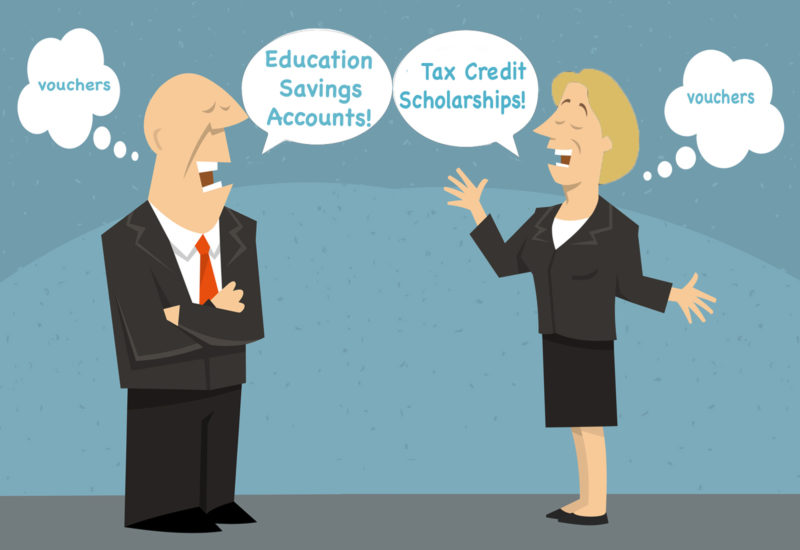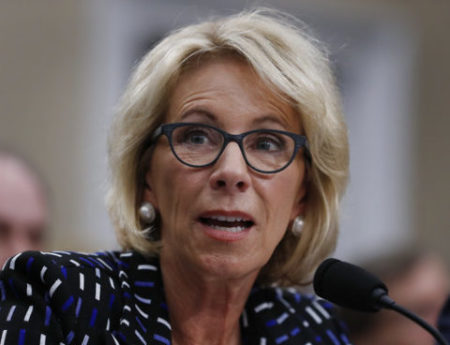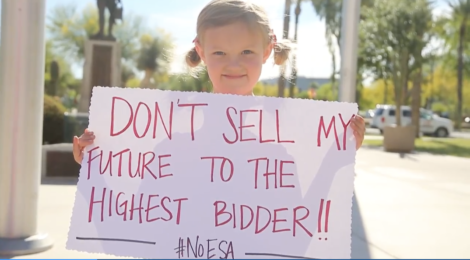 Last week, Education Secretary Betsy DeVos delivered a much-anticipated speech about her plan to shift massive amounts of valuable taxpayer money away from public schools to pay for private school vouchers. That's not exactly how she framed her ideas as she addressed the American Federation for Children (a pro-school privatization group chaired by DeVos until she was tapped to be Education Secretary). Instead, DeVos said the plan—details still to come—would amount to the "most ambitious expansion of school choice in our nation's history."
Last week, Education Secretary Betsy DeVos delivered a much-anticipated speech about her plan to shift massive amounts of valuable taxpayer money away from public schools to pay for private school vouchers. That's not exactly how she framed her ideas as she addressed the American Federation for Children (a pro-school privatization group chaired by DeVos until she was tapped to be Education Secretary). Instead, DeVos said the plan—details still to come—would amount to the "most ambitious expansion of school choice in our nation's history."
"School choice" is of course the go-to euphemism school voucher advocates use to sugarcoat a failed and unpopular idea. The general public has long been opposed to vouchers, and their academic track record is pretty grim.
Voucher devotees like DeVos know this, which is why the term "school voucher" has been ditched in favor of more appealing terms.
Take for example this line from DeVos' speech to the AFC. Praising Indiana's large-scale voucher program, she promised to "empower states and give leaders like Eric Holcomb the flexibility and opportunity to enhance choices Indiana provides its students."
In that one sentence alone, DeVos offers up four favorite euphemisms used to rebrand voucher legislation: "empower," "flexibility," "opportunity" and, of course, "choice."
 The Trump-DeVos budget would slash the federal investment in public education programs by a whopping 13.6 percent, while providing $1.4 billion in new spending on school voucher expansion. (AP Photo/Carolyn Kaster)
The Trump-DeVos budget would slash the federal investment in public education programs by a whopping 13.6 percent, while providing $1.4 billion in new spending on school voucher expansion. (AP Photo/Carolyn Kaster)
The intent is to obscure the fact that these spruced up proposals still produce the same result: less taxpayer money for public schools, more taxpayer money for unaccountable private schools that can, and do, discriminate.
The Trump budget request for fiscal year 2018 unveiled on May 23rd makes it clear that DeVos intends to deliver on this threat. NEA President Lily Eskelsen García calls the outlined education budget a "wrecking ball" to public education in service of a school privatization agenda.
"DeVos and Trump have made failed private school vouchers a cornerstone of their budget," said Eskelsen García. "Vouchers do not work and they take scarce funding away from public schools—where 90 percent of America’s students enroll—and give it to private schools that are unaccountable to the public."
As the details to DeVos' plan become clearer in the coming weeks, expect to hear more about "opportunity," "flexibility," "tax credits," "savings accounts," "scholarships"—everything except "private school vouchers." Here are a few programs touted by DeVos that, despite being smoothed out around the edges, are still at their core schemes to funnel taxpayer dollars from public schools to fund private and for-profit schools.
'Tax Credit Scholarships'
These programs, which could be a centerpiece of the administration's plan, currently exist in 17 states with more potentially ready to follow suit.
A tax credit scholarship incentivizes individual taxpayers or corporations to donate money to non-profit organizations that bundle the funds and disburse them (less their cut for administrative expenses) as private school vouchers. Donors are able to claim the donations as credits against their state tax liability and often can also claim those same donations as deductions to reduce their federal tax bill.
Advocates avoid legislative battles over the cost of a direct voucher program by using wealthy taxpayers as middlemen, says Carl Davis of the Institute on Taxation and Economic Policy.
"Rather than include line-items in state budgets for spending on school vouchers, lawmakers ask taxpayers to undertake such spending on the state’s behalf, in return for a generous tax giveaway," Davis recently wrote in The American Prospect.
Far from philanthropy, the individuals who make these donations can often get more in return than they gave by also claiming a federal charitable tax exemption—what Davis calls "double-dipping."
Davis and others label these programs "neo-vouchers" because they still, through a more circuitous route, transfer taxpayer money to private schools.
'Education Savings Accounts'
 Another "back-door voucher" is an Education Savings Account (ESA). With ESAs, a portion of a state's per-pupil education funding is put into an account that parents can tap into to pay for approved education expenses. This includes private school tuition and fees, textbooks, test prep services and tutoring, as well as a variety of other services, with no oversight over student outcomes.
Another "back-door voucher" is an Education Savings Account (ESA). With ESAs, a portion of a state's per-pupil education funding is put into an account that parents can tap into to pay for approved education expenses. This includes private school tuition and fees, textbooks, test prep services and tutoring, as well as a variety of other services, with no oversight over student outcomes.
In March, Arizona eliminated eligibility requirements from its existing ESA program. Initially aimed at students with disabilities and dubbed "Empowerment Scholarship Accounts," the program is now open to virtually all students, and, as caps ease, could include as many as 30,000 public school students by 2020. The program allows parents to take 90 percent of the money that would have gone to their school district and spend it as they see fit. The program, says Arizona State Senator Steve Farley, is nothing more than an "ESA voucher debit-cards-for-all scheme."
'Opportunity Scholarships'
The Washington, D.C., Opportunity Scholarship Program is the first and only federally funded school voucher program in the country. Created by Congress in 2004, the program provides vouchers to 1,100 low-income D.C. students, some of whom were already attending private school. Secretary DeVos would like to expand the program, ignoring a recent study that found that participants who used vouchers scored lower than their public school peers in both reading and math.
Lawmakers in North Carolina appropriated the term "opportunity scholarship" when they enacted a voucher program in 2013. The program was funded at $17.6 million in 2015-16, and up to $24.8 million in 2016-17. Meanwhile, public school funding in North Carolina has been slashed. In 2016, the state spent more than $12 million on these “scholarships,” which are expected to serve 32,000 students by 2026, at a cost of $134 million annually.
While there are no data to support the claim that voucher programs increase the opportunities for low-income children to attend higher-performing schools, there is considerable evidence that voucher programs increase the "opportunity" for more affluent families to receive public subsidies for private education. In Indiana, home to the largest voucher program in the nation, more than half of the state’s voucher recipients have never attended public schools, so Indiana taxpayers are subsidizing private school education for many students whose families could already afford it.
This slow but steady expansion of voucher programs is being duplicated elsewhere. It's become a familiar story: voucher bills are rebranded and targeted towards specific populations—low-income students or students with special needs, for example—to make them more politically palatable. Once the legislation is implemented, eligibility requirements are soon eased, and funding is increased. Meanwhile, funding for public schools is further eroded.
"For too long, these schemes have experimented with our children’s education without any evidence of real, lasting positive results," says Eskelsen García. "Improving public schools requires more money, not less, and public money should only be used to help public schools."




